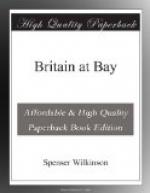A general view of the wars of the eighteenth century between Great Britain and France shows that, broadly speaking, there was no decision until the end of the period. The nearest approach to it was when Hawke destroyed the French fleet in Quiberon Bay. But this was hardly a stand-up fight. The French fleet was running away, and Hawke’s achievement was that, in spite of the difficulties of weather on an extremely dangerous coast, he was able to consummate its destruction. The real decision was the work of Nelson, and its principal cause was Nelson himself.
The British navy had discovered in its conflicts with the Dutch during the seventeenth century that the object of naval warfare was the command of the sea, which must be won by breaking the enemy’s force in battle. This was also perfectly understood by the Dutch admirals, and in those wars was begun the development of the art of fighting battles with sailing vessels. A formation, the line of battle, in which one ship sails in the track of the ship before her, was found to be appropriate to the weapon used, the broadside of artillery; and a type of ship suitable to this formation, the line-of-battle ship, established itself. These were the elements with which the British and French navies entered into their long eighteenth century struggle. The French, however, had not grasped the principle that the object of naval warfare was to obtain the command of the sea. They did not consciously and primarily aim, as did their British rivals, at the destruction of the enemy’s fleet. They were more concerned with the preservation of their own fleet than with the destruction of the enemy’s, and were ready rather to accept battle than to bring it about. The British admirals were eager for battle, but had a difficulty in finding out how a decisive blow could be struck. The orthodox and accepted doctrine of the British navy was that the British fleet should be brought alongside the enemy’s fleet, the two lines of battleships being parallel to one another, so that each ship in the British fleet should engage a corresponding ship in the French fleet. It was a manoeuvre difficult of execution, because, in order to approach the French, the British must in the first place turn each of their ships at right angles to the line or obliquely to it, and then, when they were near enough to fire, must turn again to the left (or right) in order to restore the line formation. And during this period of approach and turning they must be exposed to the broadsides of the French without being able to make full use of their own broadsides. Moreover, it was next to impossible in this way to bring up the whole line together. Besides being difficult, the manoeuvre had no promise of success. For if two fleets of equal numbers are in this way matched ship against ship, neither side has any advantage except what may be derived from the superior skill of its gunners. So long as these conditions prevailed, no great decisive victory of the kind for which we




